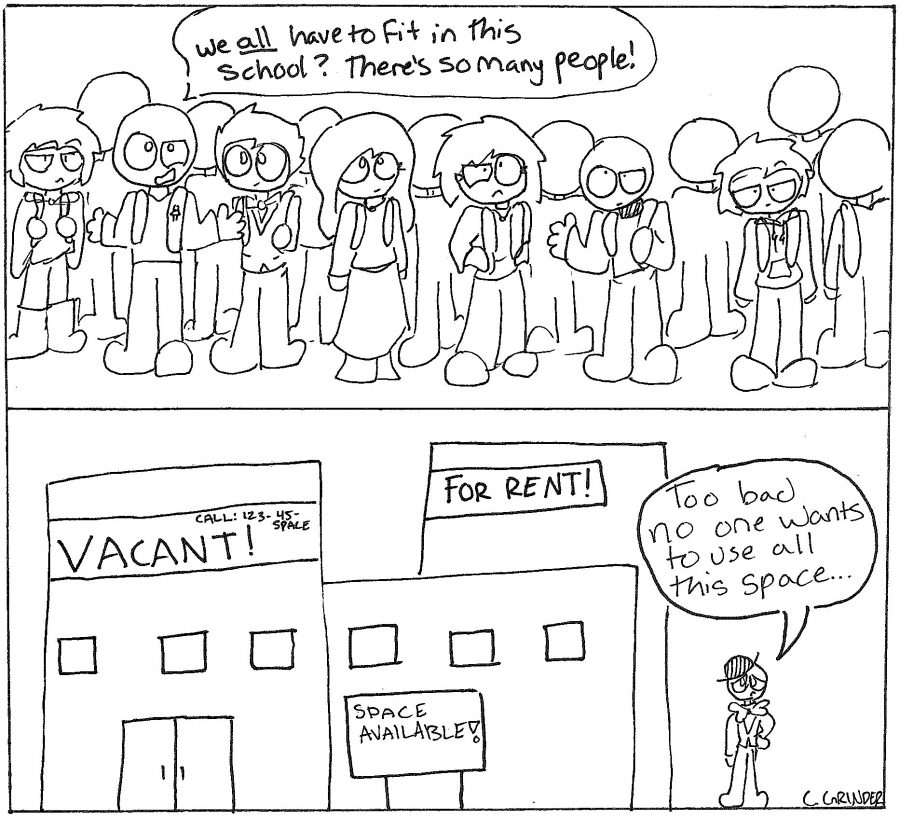County must expand facilities
FCPS should address growth by using vacant office space for schools
November 22, 2016
Fairfax County Public Schools is the 10th largest school system in the nation and enrollment is projected to grow through the 2020-2021 school year. High enrollment has created an overcrowding crisis, with Superintendent Karen Garza reporting “the school system struggles to provide sufficient capacity in our schools” in FCPS’s most recent Capital Improvement Program (CIP).
On Nov. 1, the Fairfax County Board of Supervisors (BOS) “amended location and character criteria for public school facilities,” opening the door for adapting office and commercial properties into schools. If enrollment continues to rise, converting vacant spaces into schools would be beneficial to students and Fairfax County as a whole.
In their report on the policy amendment, the BOS notes a “lack of available sites for new schools and education facilities.” Despite the lack of available space, a 2014 report on facility needs presented to the school board recommends constructing three new elementary schools and a new high school “to provide capacity relief.” Also, based on 2014-15 enrollment information, Fairfax County projects every high school in the county will reach at least 87 percent capacity by the 2019-20 school year. Many schools will be over capacity, including McLean at 129 percent.
Renovations to alleviate overcrowding won’t come in the near futur
e for most Fairfax County schools, which are currently renovated every 34 years, nine years longer than the industry standard of renovating every 25 years.
Even if schools projected to become overcrowded are due for renovations, zoning restrictions can keep schools over capacity regardless. For example, Haycock Elementary School enrolled 921 students last year. Their renovation, completed last year, provided capacity for just 877 students. At FCPS’s current growth rate, the county needs to maximize space in current facilities and take advantage of the opportunity to open schools in nontraditional locations.
According to Bisnow, a real estate news agency, there are 20 million square feet of vacant office space in Fairfax County. Adapting some of these spaces into schools instead of acquiring new sites would decrease costs and shorten construction times.
FCPS has already proved that it can successfully retrofit schools through its development of Bailey’s Upper Elementary School for Arts & Sciences. According to the BOS, FCPS purchased an office building in 2013, began adapting it in December of the same year and finished the space by September 2014. The school enrolls third, fourth and fifth graders, alleviating overcrowding at a 1,400-student school that had housed half of its students in trailers.
Since there are not adequate new sites in the county to build schools, previous plans to help with overcrowding involved adapting current administrative and community buildings.
Some advocate against opening schools in nontraditional spaces,
pointing out that the amendment allows rooftops and parking lots to be used for outdoor recreation instead of traditional playgrounds.
Cooper Carry, the architecture firm that developed Bailey’s Upper Elementary School, included “a series of exercise and movement rooms” in the school and is currently planning additional recreational spaces. The situation, while not ideal, is preferable to the large class sizes and fewer per-student resources that come with overcrowding.
Enrollment increases in the county this year were lower than in years past. However, county officials warn that this decrease is not indicative of a change in the overall trend of growth. Many schools are overcrowded in the status quo, meaning expanding facilities would be helpful even if enrollment does not increase in coming years.
Using Fairfax County’s abundant empty space will not only decrease overcrowding, but it could also improve FCPS’s ability to offer specialized educational opportunities. In their report on the amendment, the BOS said they could use buildings for transitional high schools, which serve older ESOL students and distance learning programs. Although the school system as a whole grew by less than one percent last year, enrollment in alternative programs increased nine percent.
Although expanding to new spaces could reduce some of FCPS’s crowding problems, another major limitation stems from the county’s bond-dependent CIP, which puts FCPS’s school renovation cycle well behind industry standard. The system must make compromises to ensure that it maintains current schools even as it disperses students into more facilities. Making better use of the space available in the county represents an important step in addressing FCPS’s broad facilities concerns.



